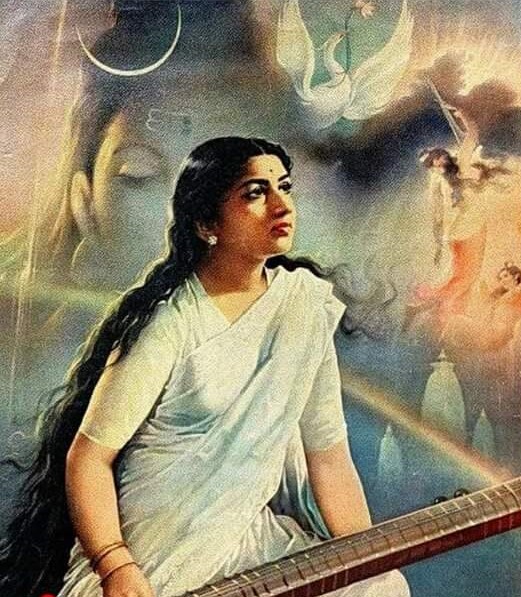

Baalamvaa Bolo Naa
Film: Picnic
Year: 1966
Composer: S. Mohinder
Raaga: Malgunji
Bageshree is a major raaga of the night. It is a shringar-pradhan raaga although other rasas can also be expressed by it. It derives from the Kafi scale and R and P are mostly varjit in aroha in the most common representation. So ‘D ‘n S m, m g (S)R S and g m D n S’ n D m P g m g (S)R S are core phrases. Note the special application of P. There are some variations in interpretation across gharanas as is the case with many raagas.
There are many great Bageshree recordings. Kishori Amonkar’s somewhat iconoclastic interpretation is considered to be one of her most popular pieces. You can see why (Watch on YouTube). Equally, many beautiful instrumental recordings exist. This historic recording of Surbahar played by Ustad Inayat Khan (father of Ustad Vilayat Khan) is exquisite. (Watch on YouTube).
Bageshree has found favor with film composers as well so there are many delightful songs. In ‘Jaao Jaao Nand Ke Laalaa’ (Rangoli; Shankar Jaikishen), Lata’s opening alaap is pitch-perfect and establishes the raaga instantly. While even most film teentaal songs prefer to start in the middle of the avartan - like classical compositions - this one starts at the ‘sam’. The song is replete with taans and fine harkats that enhance the appeal of the raaga. (Watch on YouTube).
The Bluffmaster (Kalyanji-Anandji) song-bedardi dagaabaaz jaa, by contrast, is cast in the mould of a bandish and starts with the khali of the teentaal cycle. The succinct alaap is also very good. The more languid alaap and sargam at the start of the antara is attractive, and slightly faster taans make a brief appearance in the second antara. A well-rounded composition that utilizes Lata’s strengths. (Watch on YouTube).
We make a quick detour to raag Rageshree whose scale and contours are roughly akin to Bageshree by replacing g with G, although there are other nuances to think about. There are two very nice Lata songs based on this raag. The C Ramchandra classic- mohabbat aisee dhadkan hai from Anarkali dwells on the core melody and eschews overtly classical harkats. (Watch on YouTube). But in the Jagir song- maane naa maane naa manmohan, Madan Mohan uses a proper alaap and the flavor is more classical. (Watch on YouTube). Both are compelling Lata songs.
Raag Malgunji is obtained by combining Bageshree with Khamaj. Due the presence of both gandhars it is sometimes thought to impinge on the boundary between Bageshree and Rageshree, although the use of the shuddha G via ‘D ‘n S R G m is special and unique to Malgunji. It is a Gwalior specialty raaga - listen to this lovely tarana in jugalbandi between Pts. Vinayakrao Patwardhan and Narayanro Vyas. (Watch on YouTube). On the instrumental side, this violin recording of Ustad Allaudin Khan is a superb representative. (Watch on YouTube).
It is surprising that this relatively esoteric raag has found favor among film composers. While one iconic Lata-Hemant duet (jaag dard-e-isq, Anarkali, C.Ramchandra (Watch on YouTube). represents Bageshree, another one (nain so nain, Jhanak Jhanak Payal Baje, Vasant Desai (Watch on YouTube),represents Malgunji! In the latter, there are some nice short taans tracing the raaga contours and the overall mood is soft and romantic.
Three other Lata songs are based on this raag - ghar aa jaa ghir aaye (Watch on YouTube), unko ye shikaayat hai (Watch on YouTube) and na jiya laage na (Watch on YouTube) are based to varying degrees on this melody.
The main song is ‘balamwa bolo na’ from Picnic (S. Mohinder). The opening alaap is soft and compact, employing Malgunji phrases and setting the tone for the melody. Like many classical songs from films, this one is also a dance song. It employs many harkats inspired by the Bandish ki Thumri format, such as harkats that enhance the mood of the song and the poetry. The plaintive ‘bolo naa, bolo naa, bolo naa’ with very subtle variations is the heart of the song, while the coaxing ‘baalamva’ and ‘kit jaaon’ provide additional grist to the emotion mill. The overall impression is that it is a sweet song, and the honey-dipped Lata voice is just right for it.
Author info is not available!